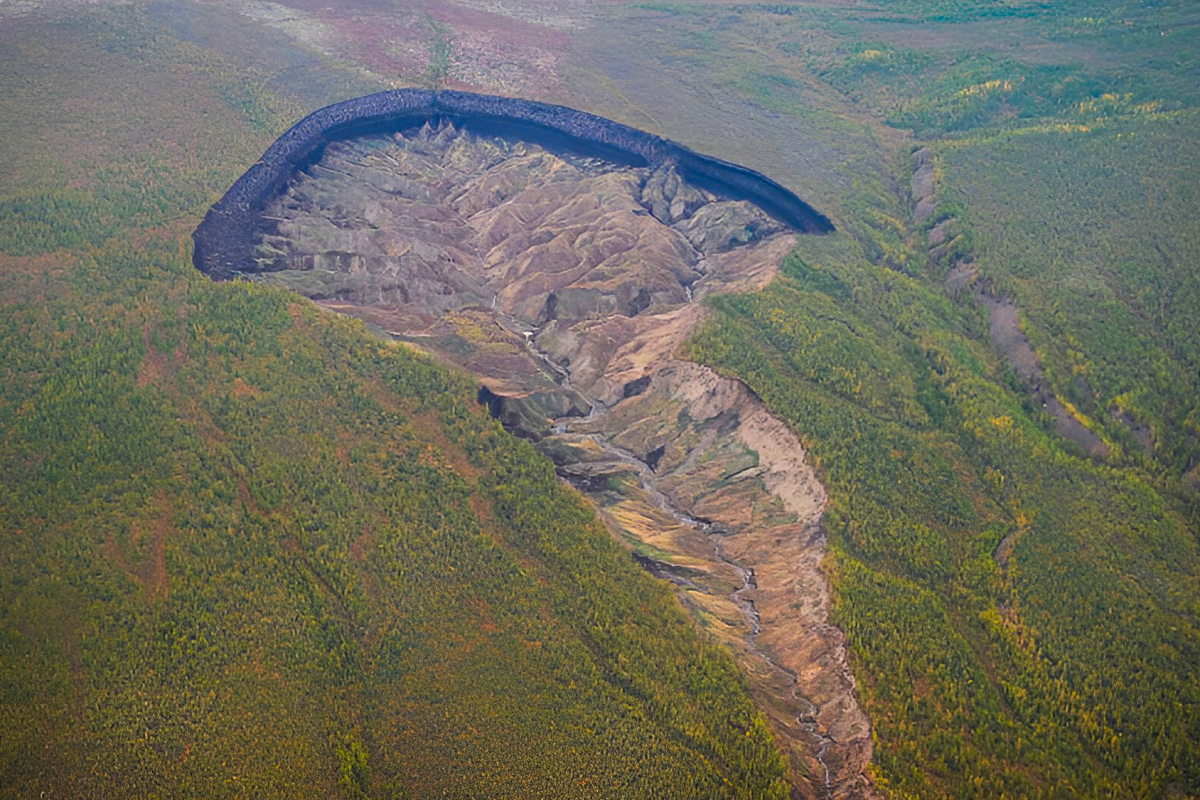
Fill this up with water and we have a mysterious kettle lake which happens to be a common feature in all former Ice Age lands. Now we we see one been made.
This was an unsolved problem , by the way. obviously this solves it. I do suspect it is triggered by a frozen methane collapse as just blaming climate change is absurd.
worth seeing though, because it is unique to visit while in formation. a lot of geology only leaves a mess and no explanation. I personally visited a perpetual gas flame in Bellingham coming out of an eighteen inch casing pipe. I realized driving in that we were following a fault tear conforming to the Juan de Fuca strait that ruptured three hundred years ago.
I saw it, but who did? And who sees a kettle lake setting up?
Earth's 'Gateway to Hell' is growing by 35 million cubic feet each year
May 08, 2024
This ever-growing permafrost-destroying 'sink hole' was originally a small gully in the 1960s
Murton et al/Permafrost Periglacial Processes
https://newatlas.com/environment/siberia-doorway-to-hell-batagaika-crater/?
Whether you're a John Carpenter fan or a biology enthusiast, you shouldn't need much convincing to know that the melting of subterranean permafrost at the poles is not a good thing. Last year, scientists gave us one more thing to lose sleep over, reviving a 48,500-year-old 'zombie virus' unearthed from Arctic permafrost – and it was not the first time. It's one more sting in the tail of climate change – the threat of ancient diseases that have lain frozen and dormant for millennia.
Now, new research has detailed the rate at which Siberia's massive Batagaika crater is devouring the surface of the Earth, expanding at a rate of 35 million cubic feet each year. Currently, it measures around 1 km (0.6 mi) long and 800 m (0.5 mi) across at its widest point. And it's speeding up.
Batagaika crater, located in the Chersky Range in northeastern Siberia, is not actually a crater but a thermokarst depression – a kind of sinkhole or 'mega-slump' driven by the collapse and fracturing of land due to permafrost loss. It was only discovered in 1991, after this underground opening split further and took with it a large section of hillside. In the video below, you can see its growth from discovery to 2007.
Image of the Week: Batagaika Crater and the Megaslump
Permafrost, despite its name, is not actually permanent; it's essentially ground that's remained at 32°F (0°C) or colder for more than two years. A quarter of the Northern Hemisphere's land surface is made up of this rock-hard frozen dirt that can vary between a a few feet deep to almost a mile.
So why is Batagaika – which is in a fairly remote area of Siberia – causing such alarm? Its rapid expansion is now fueled by warming air temperatures, which has set off a positive feedback loop that's unlikely to slow down as long as there's ice to thaw.
When the permafrost layer degrades, or melts, it goes from concrete consistency to a muddy mass, which is unable to support the vegetation on the surface. As the edges of the expanse collapse into it, the ground loses the canopies of trees shielding it from the sun (and heat). At this point, newly-exposed organic matter, no longer preserved in ice, breaks down and releases carbon into the atmosphere to further fuel atmospheric warming. This, of course, results in increasingly more permafrost loss.
The rapid growth of the Batagaika Crater, as seen in satellite images, from 1991-2022.
Earth Resources Observation and Science (EROS) Center
As for the ancient bugs, we don't know whether they're equipped to survive for long when exposed to the Earth's atmosphere – but nor do we know if our modern biology and medicine is equipped to deal with novel viruses returning from 50,000 years of dormancy. In 2016, it's believed a permafrost thaw released the anthrax-causing Bacillus anthracis, which killed 2,649 reindeer, and resulted in dozens of sick locals and the death of one child.
The dramatic Batagaika crater formation – which has earned it the nicknames of 'gateway to the underworld' and 'gateway to Hell' – has steep cliff-like edges revealing permafrost estimated to have been frozen for 650,000 years. It's currently around 50 m (164 ft) deep, with areas dropping down 100 meters (328 feet).
And the good news? Well, it has become somewhat of a tourist attraction...
The Batagaika Crater : A warning sign for the Earth
No comments:
Post a Comment